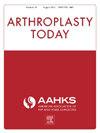Automated Impaction Improves Femoral Component Canal Fit in Total Hip Arthroplasty: A Matched Study
IF 2.1
Q3 ORTHOPEDICS
引用次数: 0
Abstract
Background
Automated impaction in total hip arthroplasty (THA) is a new technology in femoral canal preparation. Recent studies have shown that it improves component alignment and fit and reduces operative time. The purpose of our study is to further investigate this technology’s impact on femoral component canal fit, fracture risk, and operative time.
Methods
We conducted a retrospective, matched analysis of 274 patients who underwent THA via automated impaction (N = 137) or manual impaction (N = 137). Postoperative radiographs were assessed to measure canal fill (CF) at the level of the neck cut, the lesser trochanter (LT), and 10 mm above (LT+10) and 60 mm below (LT−60) the LT. The average CF across these measurement points was calculated. The incidence of intraoperative fracture and average CF percentage were compared between the two cohorts.
Results
The average CF percentage was significantly higher in the automated cohort (79.6 ± 5.6) than in the manual cohort (76.3 ± 5.6) (P < .001) as well as at each individually measured level. Operative time was significantly less in the automated cohort (93.9 ± 12.5) vs manual (100.6 ± 21.7 mins) (P = .006). There was no difference in the risk of intraoperative fracture (automated = 1/137 [0.7%] vs manual = 2/137 [1.5%], P = 1.00).
Conclusions
Our study results suggest that automated femoral canal impaction improved CF and reduced operative time without introducing additional risk of intraoperative fracture in THA. Of note, these results cannot determine whether automated impaction has clinical benefit with respect to pain, function, or survivorship of the femoral component.
全髋关节置换术中自动内塞改善股骨假体管配合度:一项匹配研究
背景全髋关节置换术(THA)中的自动内压是股骨管预备的新技术。最近的研究表明,它改善了组件对齐和配合,缩短了手术时间。我们研究的目的是进一步探讨该技术对股骨假体管配合度、骨折风险和手术时间的影响。方法我们对274例通过自动压入(N = 137)或手动压入(N = 137)行THA的患者进行回顾性匹配分析。评估术后x线片以测量颈部切口、小转子(LT)以及LT上方10 mm (LT+10)和下方60 mm (LT - 60)的管腔填充(CF)。计算这些测量点的平均CF。比较两组患者术中骨折发生率和平均CF百分比。结果自动队列的平均CF百分比(79.6±5.6)显著高于人工队列(76.3±5.6)(P < 0.001),且各单项水平均显著高于人工队列(76.3±5.6)。自动队列的手术时间(93.9±12.5分钟)明显少于手动队列(100.6±21.7分钟)(P = 0.006)。术中骨折风险无差异(自动= 1/137 [0.7%]vs手动= 2/137 [1.5%],P = 1.00)。结论自动股骨管内嵌可改善CF,缩短手术时间,且不会增加THA术中骨折的风险。值得注意的是,这些结果不能确定自动内塞是否对股骨假体的疼痛、功能或存活有临床益处。
本文章由计算机程序翻译,如有差异,请以英文原文为准。
求助全文
约1分钟内获得全文
求助全文
来源期刊

Arthroplasty Today
Medicine-Surgery
CiteScore
2.90
自引率
0.00%
发文量
258
审稿时长
40 weeks
期刊介绍:
Arthroplasty Today is a companion journal to the Journal of Arthroplasty. The journal Arthroplasty Today brings together the clinical and scientific foundations for joint replacement of the hip and knee in an open-access, online format. Arthroplasty Today solicits manuscripts of the highest quality from all areas of scientific endeavor that relate to joint replacement or the treatment of its complications, including those dealing with patient outcomes, economic and policy issues, prosthetic design, biomechanics, biomaterials, and biologic response to arthroplasty. The journal focuses on case reports. It is the purpose of Arthroplasty Today to present material to practicing orthopaedic surgeons that will keep them abreast of developments in the field, prove useful in the care of patients, and aid in understanding the scientific foundation of this subspecialty area of joint replacement. The international members of the Editorial Board provide a worldwide perspective for the journal''s area of interest. Their participation ensures that each issue of Arthroplasty Today provides the reader with timely, peer-reviewed articles of the highest quality.
 求助内容:
求助内容: 应助结果提醒方式:
应助结果提醒方式:


